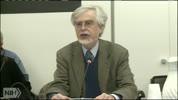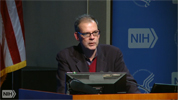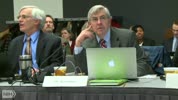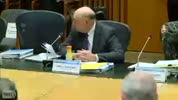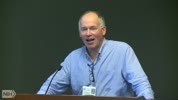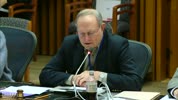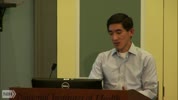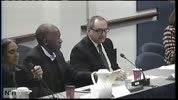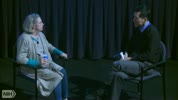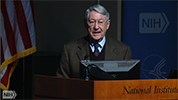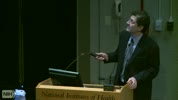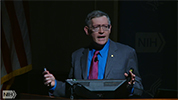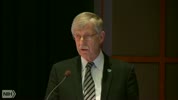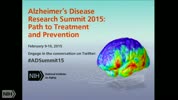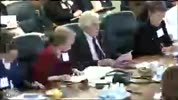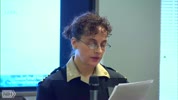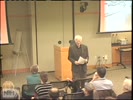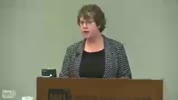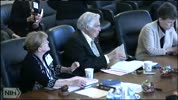-
- NIH VideoCast - National Advisory Council on Aging - January 2015
-
- - Dr. Richard Hodes, NIA, NIH and Dr. Robin A. Barr, NIA, NIH (2015/03/31)
- - Category : Advisory Board Meetings
- The National Advisory Council on Aging (NACA) advises the Secretary of the U.S. Department of Health and Human Services, the Director of NIH, and the Director of NIA on its mission. The Council meets three times a year to consider applications for research and training.
NIH VideoCast - National Advisory Council on Aging - January 2015
-
- NIH VideoCast - Insights into Microbial Pathogenesis and Immunology from Cryptococcus Neoformans
-
- - Arturo Casadevall, M.D., Ph.D., Professor in the Department of Medicine and in the Department of Microbiology and Immunology, Albert Einstein College of Medicine; Chair, Department of Molecular Microbiology and Immunology, Johns Hopkins Bloomberg School of Public Health (2015/03/31)
- - Category : WALS - Wednesday Afternoon Lectures
- Wednesday Afternoon Lecture Series
The majority of human pathogenic fungi are soil-dwelling microbes that have no obvious need for animal hosts. This raises a fundamental question in microbial pathogenesis: Why do some of these organisms cause disease in mammals? In this lecture we will dissect the biology of the human pathogenic fungus Cryptococcus neoformans in an effort to glean an explanation for the origin of virulence. C. neoformans is an intracellular pathogen with a remarkable replicative strategy that includes the capacity for exciting the host cell without triggering its lysis. This process involves inflicting just enough damage to the host cell to interfere with its microbicidal properties without triggering cell-death pathways such that intracellular replication can proceed unhindered while the host cell remains alive to participate in the exit of fungal cells. The similarity in the interactions between cryptococcal cells with macrophages and amoeba has led to the proposal that the cells` capacity for mammalian virulence emerged accidentally as a result of environmental interactions with phagocytic predators. In this lecture we will also explore the fascinating properties of melanin, an enigmatic pigment that performs a myriad of functions from enhancing cell-wall integrity to energy transduction. We will also consider some of the immunological lessons from studying C. neoformans, which produced important insights into novel antibody protective functions. Finally, we will look at the big picture of fungal pathogenesis and explore the concept of accidental virulence and the likelihood that global warming will bring new fungal diseases.
NIH VideoCast - Insights into Microbial Pathogenesis and Immunology from Cryptococcus Neoformans
-
- NIH VideoCast - National Advisory Neurological Disorders and Stroke Council Meeting - January 2015
-
- - National Institute of Neurological Disorders and Stroke, NIH (2015/03/31)
- - Category : National Institute of Neurological Disorders and Stroke
- The 192nd meeting of the National Advisory Neurological Disorders and Stroke Council.
For more information go to http://www.ninds.nih.gov/find_people/nands/index.htm
NIH VideoCast - National Advisory Neurological Disorders and Stroke Council Meeting - January 2015
-
- NIH VideoCast - Council of Councils - January 2015
-
- - James M. Anderson MD PhD (2015/03/31)
- - Category : Council of Councils
- The Council of Councils was created by the NIH Reform Act of 2006, and advises on matters related to the policies and activities of DPCPSI, including concept clearance of selected initiatives for Common Fund support and proposed Office of Research Infrastructure Program (ORIP) initiatives. The Council conducts second-level review for selected Common Fund and ORIP initiatives.
For more information go to http://dpcpsi.nih.gov/council/index
NIH VideoCast - Council of Councils - January 2015
-
- NIH VideoCast - The Generation of Cortical Interneuron Diversity: Both Nurture and Nature
-
- - Gordon Fishell, Ph.D., New York University (2015/03/31)
- - Category : Neuroscience
- Neuroscience Seminar Series
The Fishell laboratory is focused on how the diversity of local circuit GABAergic inhibitory interneurons is created. Understanding how this is accomplished during development remains one of the most daunting problems in biology. In particular, they wish to understand not only how the vast variety of inhibitory interneuron subtypes are generated but how they subsequently integrate into the bewildering array of neural circuits that are embedded in different brain structures. Their working hypothesis is that this is achieved through a two-step process. The first involves genetic programs that in accordance with their birthdate create a finite number of cardinal interneuron subtypes (Research Topic 1 - The Embryonic Specification of Interneurons). Following the tiling of these newly born cardinal subtypes across different brain structures, local cues act to create the definitive subtypes characteristic of the distinct cortical and subcortical areas (Research Topic 2 - Interneuron Integration and Synapse Formation). Importantly, as they have explored the molecular control of these events, it has become clear that perturbation of this process can result in a variety of brain dysfunctions including autism spectrum disorder (ASD), intellectual disability (ID) and schizophrenia. A new and growing interest in the laboratory is therefore aimed at seeing if better understanding of these developmental events can lead to the development of new treatments for these disorders (Research Topic 3 - Interneuron Function and Dysfunction).
NIH VideoCast - The Generation of Cortical Interneuron Diversity: Both Nurture and Nature
-
- NIH VideoCast - Frederick National Laborartory Advisory Committee (FNLAC) Meeting - February 2015
-
- - NCI, NIH (2015/03/31)
- - Category : NCI Frederick Advisory Committee
- The 8th meeting of the Frederick National Laboratory Advisory Committee (FNLAC)
NIH VideoCast - Frederick National Laborartory Advisory Committee (FNLAC) Meeting - February 2015
-
- NIH VideoCast - Demystifying Medicine 2015 - Tuberculosis: Return of the White Plague
-
- - Ray Chen, M.D., NIAID, NIH and Clifton Barry, Ph.D., NIAID, NIH (2015/03/31)
- - Category : Demystifying Medicine
- The 2015 Demystifying Medicine Series, which is jointly sponsored by FAES and NIH, will begin January 6th and includes the presentation of patients, pathology, diagnosis and therapy in the context of major disease problems and current research. Primarily directed toward Ph.D. students, clinicians and program managers, the course is designed to help bridge the gap between advances in biology and their application to major human diseases. Each session includes clinical and basic science components presented by NIH staff and invitees. All students, fellows and staff are welcome, as well.
For more information go to http://demystifyingmedicine.od.nih.gov/
NIH VideoCast - Demystifying Medicine 2015 - Tuberculosis: Return of the White Plague
-
- NIH VideoCast - Collaborative Research on Addiction at NIH (CRAN) Joint Advisory Council Meeting - February 2015
-
- - NIDA, NIAAA and NCI (2015/03/31)
- - Category : Advisory Board Meetings
- The 3rd Joint Meeting of the Advisory Councils of NIAAA, NIDA, and NCI will include presentation of the IC Directors` report on the Collaborative Research on Addiction at NIH (CRAN).
NIH VideoCast - Collaborative Research on Addiction at NIH (CRAN) Joint Advisory Council Meeting - February 2015
-
- NIH VideoCast - Ethics Rounds: Should We Compensate Subjects for Research Related Injuries?
-
- - Kenneth Feinberg, JD, Administrator, September 11 Victim Compensation Fund of 2001; and One Fund Boston, the Compensation Program following the Boston Marathon Bombings and Case Presenter: Jean Burns, MA, NIH Clinical Trial Volunteer (2015/03/31)
- - Category : Clinical Center Grand Rounds
- Ethics Rounds: Should We Compensate Subjects for Research Related Injuries?
For more information go to http://www.cc.nih.gov/about/news/grcurrent.html
NIH VideoCast - Ethics Rounds: Should We Compensate Subjects for Research Related Injuries?
-
- NIH VideoCast - Tracing the Evolution of Adaptive Immunity
-
- - Max D. Cooper, M.D., Eminent Scholar, Georgia Research Alliance; Professor, Department of Pathology and Laboratory Medicine, Emory University School of Medicine (2015/03/31)
- - Category : WALS - Wednesday Afternoon Lectures
- NIH Director`s Wednesday Afternoon Lecture
A search for the origin of our adaptive immune system has revealed that the jawed vertebrates and jawless vertebrates (lampreys and hagfish) use different strategies for generating large repertoires of lymphocyte receptors for antigens. Whereas lymphocytes in jawed vertebrates undergo RAG-mediated recombinatorial assembly of immunoglobulin V, D, and J gene segments to generate diverse T-cell receptor (TCR) and B-cell receptor (BCR) repertoires, lymphocytes in jawless vertebrates employ leucine-rich repeat (LRR) gene segments as templates to complete the assembly of variable lymphocyte receptor (VLR) genes. Three VLR loci (VLRA, VLRB and VLRC) undergo independent assembly during the differentiation of three distinct lymphocyte lineages. The VLRA-bearing and VLRC-bearing lymphocytes have genetic programs and phenotypic characteristics that resemble those of certain T cells of jawed vertebrates, whereas the VLRB-bearing cells resemble B cells. Dr. Cooper???s lab concludes that the basic genetic programs for the T- and B-cell lineages were already present in a common vertebrate ancestor more than 500 million years ago, prior to the convergent evolution of different types of anticipatory receptors.
NIH VideoCast - Tracing the Evolution of Adaptive Immunity
-
- NIH VideoCast - Tracking CD4 T-Cells After Infection
-
- - Dr. Marc Jenkins, University of Minnesota (2015/03/31)
- - Category : Immunology
- Immunology Interest Group
For more information go to http://sigs.nih.gov/immunology/Pages/default.aspx
NIH VideoCast - Tracking CD4 T-Cells After Infection
-
- NIH VideoCast - Age-related Alterations in Neutrophil Recruitment and Impact on Chronic Inflammation
-
- - Dr. George Hajishengallis, Professor of Microbiology, Penn Dental Medicine (2015/03/31)
- - Category : Geroscience
- The Trans-NIH GeroScience Interest Group (GSIG) cordially invites you to its winter seminar, featuring Dr. George Hajishengallis. Dr. Hajishengallis is a Professor of Microbiology at Penn Dental Medicine. His field of interest lies at the interface of microbial pathogenesis and immunity, and his work has illuminated important mechanisms of immunopathogenesis of well-adapted pathogens that exploit the human immune system and subvert it to their own advantage. His interests also include the impact of aging on inflammatory diseases.
The GeroScience Interest Group (GSIG) was formed to enhance opportunities for discussion of the intersection between the biology of aging and the biology of disease and conditions that are of interest across ICs. It is focused on basic biology, but with a longer view towards translation. If you are interested in learning more, please visit the GSIG web site http://sigs.nih.gov/geroscience/Pages/default.aspx.
NIH VideoCast - Age-related Alterations in Neutrophil Recruitment and Impact on Chronic Inflammation
-
- NIH VideoCast - Special NIH Nobel Laureate Lecture - The Story of Single Molecules, from Early Spectroscopy in Solids to Super-Resolution Nanoscopy in Cells and Beyond
-
- - W.E. Moerner, Ph.D., 2014 Nobel Laureate, Harry S. Mosher Professor of Chemistry and Professor (by courtesy) of Applied Physics Stanford University (2015/03/31)
- - Category : Special
- Special NIH Nobel Laureate Lecture
Dr. W.E. Moerner, who shared the 2014 Nobel Prize in chemistry for the development of super-resolution fluorescence microscopy, will discuss his pioneering work in a special NIH lecture titled ???The Story of Single Molecules, from Early Spectroscopy in Solids to Super-Resolution Nanoscopy in Cells and Beyond.???
For more information go to http://www.nigms.nih.gov/News/meetings/Pages/single-molecules.aspx
NIH VideoCast - Special NIH Nobel Laureate Lecture - The Story of Single Molecules, from Early Spectroscopy in Solids to Super-Resolution Nanoscopy in Cells and Beyond
-
- NIH VideoCast - Alzheimer`s Disease Research Summit 2015: Path to Treatment and Prevention (Day 1)
-
- - National Institute on Aging, NIH, DHHS (2015/03/31)
- - Category : Conferences
- The goal of the Alzheimer`s Disease Research Summit 2015 is to continue the development of an integrated multidisciplinary research agenda to address critical knowledge gaps and accelerate discovery and delivery of successful interventions for people at all stages of the disease. Toward that goal, the 6-session agenda brings together speakers and panelists from different disciplines in academia, industry, federal agencies, private foundations, and public advocacy groups working on Alzheimer`s and other complex diseases in an effort to share ideas and most effectively move research forward.
For more information go to http://www.nia.nih.gov/about/events/2014/alzheimers-disease-research-summit-2015
NIH VideoCast - Alzheimer`s Disease Research Summit 2015: Path to Treatment and Prevention (Day 1)
-
- NIH VideoCast - Alzheimer`s Disease Summit 2015: Path to Treatment and Prevention (Day 2)
-
- - National Institute on Aging, NIH, DHHS (2015/03/31)
- - Category : Conferences
- The goal of the Alzheimer`s Disease Research Summit 2015 is to continue the development of an integrated multidisciplinary research agenda to address critical knowledge gaps and accelerate discovery and delivery of successful interventions for people at all stages of the disease. Toward that goal, the 6-session agenda brings together speakers and panelists from different disciplines in academia, industry, federal agencies, private foundations, and public advocacy groups working on Alzheimer`s and other complex diseases in an effort to share ideas and most effectively move research forward.
For more information go to http://www.nia.nih.gov/about/events/2014/alzheimers-disease-research-summit-2015
NIH VideoCast - Alzheimer`s Disease Summit 2015: Path to Treatment and Prevention (Day 2)
-
- NIH VideoCast - National Library of Medicine - Board of Regents, Advisory Council (Day 1)
-
- - Dr. Donald A.B. Lindberg, NLM, NIH (2015/03/31)
- - Category : Advisory Board Meetings
- NLM Advisory Council Meeting
Board of Regents Agenda
For more information go to http://www.nlm.nih.gov/od/bor/bor.html
NIH VideoCast - National Library of Medicine - Board of Regents, Advisory Council (Day 1)
-
- NIH VideoCast - WRNRC Spring 2015 Educational Offering
-
- - Washington Regional Nursing Research Consortium and Clinical Center Nursing Department, NIH (2015/03/31)
- - Category : Special
- To discuss the incorporation of patient reported outcomes (PRO) in both research and clinical care including recent advances in measurement systems such a Patient-Reported Outcome Measurement Information System (PROMIS)
NIH VideoCast - WRNRC Spring 2015 Educational Offering
-
- NIH VideoCast - Demystifying Medicine 2015 - Ras: a Cancer Mechanism and Target
-
- - Frank McCormick, PhD, FRS, DSc (Hon) UCSF, NCI, NIH and Susan Bates, MD, NCI, NIH (2015/03/31)
- - Category : Demystifying Medicine
- The 2015 Demystifying Medicine Series, which is jointly sponsored by FAES and NIH, will begin January 6th and includes the presentation of patients, pathology, diagnosis and therapy in the context of major disease problems and current research. Primarily directed toward Ph.D. students, clinicians and program managers, the course is designed to help bridge the gap between advances in biology and their application to major human diseases. Each session includes clinical and basic science components presented by NIH staff and invitees. All students, fellows and staff are welcome, as well.
For more information go to http://demystifyingmedicine.od.nih.gov/
NIH VideoCast - Demystifying Medicine 2015 - Ras: a Cancer Mechanism and Target
-
- NIH VideoCast - Building a Large U.S. Cohort for Precision Medicine Research (Day 1)
-
- - National Institutes of Health (2015/03/31)
- - Category : Conferences
- On February 11-12, NIH will host a workshop to discuss the opportunities and challenges around building a large research cohort focused on precision medicine. We look forward to hearing from leading experts from many disciplines and sectors.
For more information, visit
http://www.nih.gov/precisionmedicine/workshop.htm
NIH VideoCast - Building a Large U.S. Cohort for Precision Medicine Research (Day 1)
-
- NIH VideoCast - National Library of Medicine - Board of Regents, Advisory Council (Day 2)
-
- - Dr. Donald A.B. Lindberg, NLM, NIH (2015/03/31)
- - Category : Advisory Board Meetings
- NLM Advisory Council Meeting
Board of Regents Agenda
For more information go to http://www.nlm.nih.gov/od/bor/bor.html
NIH VideoCast - National Library of Medicine - Board of Regents, Advisory Council (Day 2)



